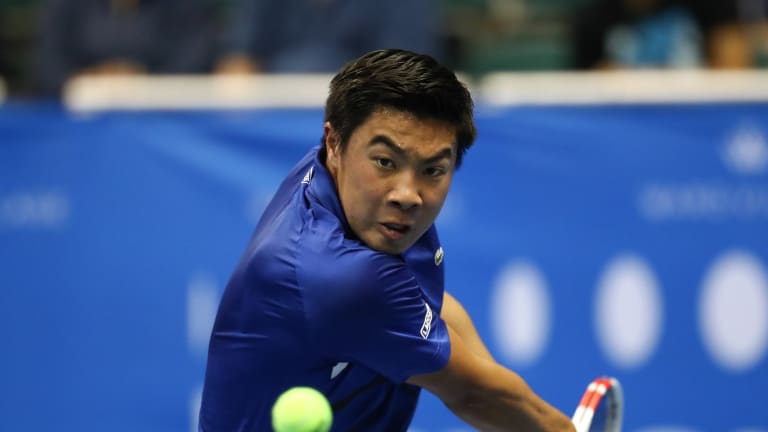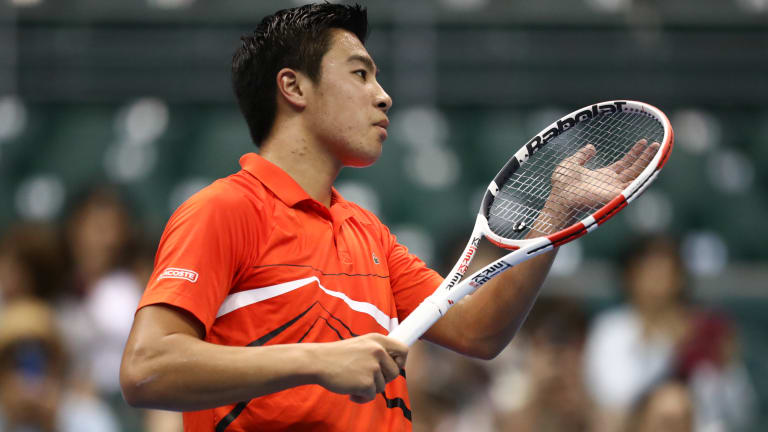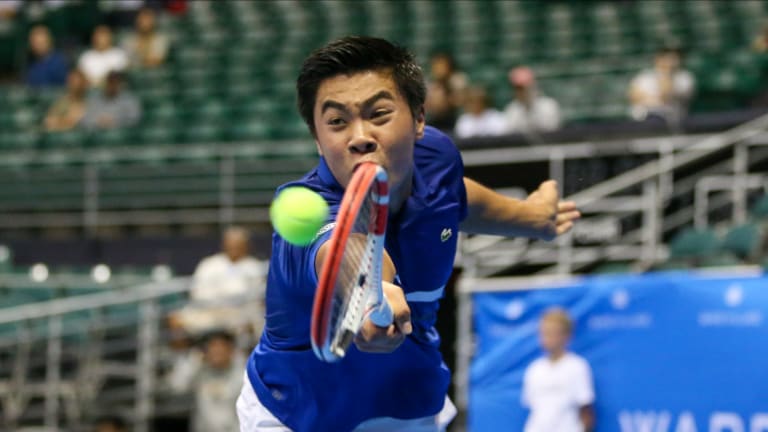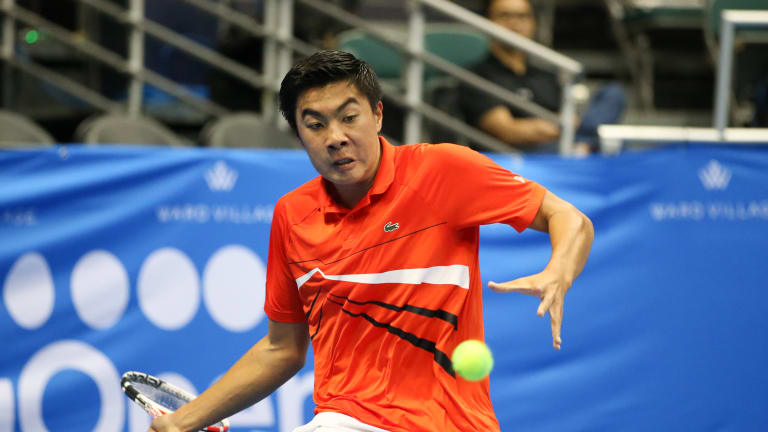"Not a fluke": Brandon Nakashima craving for bigger breakthrough
By Steve Flink Dec 15, 2020Tommy Paul, Frances Tiafoe lead eight Americans into quarterfinals in Houston
By John Berkok Apr 04, 2025Five American men are through to the round of 16 at Indian Wells for the first time since 2004
By John Berkok Mar 11, 2025Stomach issues hit Casper Ruud, Tommy Paul, Holger Rune on day where Acapulco's top five seeds all bow out
By TENNIS.com Feb 27, 2025Time travel, teleportation and ... onion cream soup? ATP players pick their superpower
By Baseline Staff Nov 01, 2024Ugo Humbert improves to 3-0 against Brandon Nakashima with Paris Masters win
By Associated Press Oct 28, 2024Brandon Nakashima sinks Frances Tiafoe in Tokyo before Ben Shelton denies Reilly Opelka
By TENNIS.com Sep 26, 2024U.S. beats Germany to secure top spot in Davis Cup Finals group
By Associated Press Sep 14, 2024U.S. dismisses Slovakia to join Germany in qualifying for Davis Cup Finals knockout stage
By Associated Press Sep 13, 2024U.S. sweeps Chile with three decisive tie-break wins to open Davis Cup Finals group play
By Associated Press Sep 11, 2024"Not a fluke": Brandon Nakashima craving for bigger breakthrough
"I would like to keep improving my ranking, do well at the Grand Slams in 2021 and hopefully win an ATP tournament," the American says.
Published Dec 15, 2020
Advertising
When I first spoke with Brandon Nakashima late last winter, he had come off a remarkable run as a wild card to reach the quarterfinals of the ATP 250 event in Delray Beach. He went from there to California for a Challenger tournament at Indian Wells, and made it to the semifinals. He was unmistakably on the upswing, climbing significantly on the ladder of the sport, and looking forward to as stellar a season as possible.
But Nakashima’s world was thrown into turmoil—along with everyone else’s in his profession—as the pandemic caused the cancellation of the BNP Paribas Open, also held at Indian Wells. Yet he made the most of his five months away from official tournament tennis, endured some difficult times in the autumn that were beneficial to his growth as a competitor, and then closed out 2020 in style with a triumph at a Challenger tournament in Orlando.
I had another interview with Nakashima this past week, and was impressed once more by his maturity. Nakashima is only 19 but he comes across like someone five to ten years older. He was comforted by winning the title in Orlando and thus moving up to No. 166 in the world. In five matches he did not lose a set, including victories over fellow Americans Mitchell Krueger and Mackenzie McDonald.
Reflecting on Orlando, Nakashima says, “I was putting a lot of pressure on myself even though I knew I was going to be in a good position coming into 2021 anyway. It was great to come away with a title and to improve my ranking and head into next year progressing in a positive direction. I had a clear game plan for each opponent and played well in all of the matches.”
The wins over Krueger and McDonald were particularly significant. Nakashima knows them both well. They are tuned into the intricacies of his game, and vice versa.

"Not a fluke": Brandon Nakashima craving for bigger breakthrough
© 2019 Getty Images
Advertising
Getty Images
“I do know them well,” says Nakashima, the youngest American—and one of only four teenagers worldwide—in the Top 200 of the ATP Rankings. “I have practiced with them numerous times. I knew Mackenzie would be tough. He likes the ball flat in the strike zone most of the time. I had to change the pace, give him more variety and get the balls heavy and up a little bit. Krueger had a long day in singles and doubles the day before I played him so maybe he was a step slow but overall I played well and that was good going into the finals [against world No 137 Prajnesh Gunneswaran]. He hit a pretty big ball off both sides but I got one crucial break in each set and beat him in two sets playing at a high level.”
Making his win in Florida all the more gratifying was moving past the difficult stretch which preceded it. He lost in the first round of qualifying at the Cincinnati in New York tournament before advancing to the second round of the US Open and taking Alexander Zverev to four sets. But then in his next five tournaments he struggled inordinately to win matches as he became acclimated with European clay.
But back on the hard courts in the U.S., Nakashima found his form with a quarterfinal showing at the Cary, North Carolina Challenger, followed by his triumphant run in Orlando. A good beginning to the year was followed by a hard-luck middle of the season but it all ended on a high note. That made it all worthwhile.
“Getting a wild card into the US Open was a cool experience,” he reflects. “Having a close match with Zverev gave me a lot of confidence that I can compete with those top guys. That was great. But I knew when I decided to turn professional that I was going to have good and bad moments in my career. After all of the success at the beginning of this year and at the US Open, it was tough to have all of those tournaments back to back in Europe. I didn’t have the results I wanted, but that is why you have your coaches and family to get you through those tough times. They give you motivation and tell you to trust the process. I did that.”
From Delray Beach until October, one of his coaches was Pat Cash. They split up amicably but Nakashima is grateful for the wisdom that the 1987 Wimbledon champion passed on to him while they were together.
“It was a fantastic experience this past year in getting to know Pat,” says Nakashima. “Any time you get to be around a Grand Slam champion, it is nice. I definitely learned a lot from him. Spending time with Pat on and off the court was great for me. We decided to go in different directions going forward but I wish him nothing but the best.”

"Not a fluke": Brandon Nakashima craving for bigger breakthrough
© 2019 Getty Images
Advertising
Getty Images
Cash, however, was not the only coach to guide him capably this past season. Also in his corner then—as he will be in the coming campaign—was the Serbian Dusan Vemic. Vemic has served as an assistant coach for Novak Djokovic off and on over the past decade. He started working regularly with Nakashima in May.
“Dusan has definitely played a big role in my success this year,” Nakashima points out. He was with me for the majority of those six months during the pandemic along with Pat. All of us were working hard on my game. Dusan has been really good and has given me a lot of life lessons along the way.”
Vemic is highly impressed with his young pupil and optimistic about where they can go from here. He says, “Brandon is a great student of the game and a great young man who is hungry to learn, grow and get better. He is one of those special tennis players that seizes opportunities. He plays his best and focusses especially well under pressure.
“I have told him since I joined him that he reminds me of Novak in many ways in the way he approaches challenges. Brandon’s tennis IQ is very high and his instincts are great. Some players are not ready to battle every single day, but somehow he can. He does bring it every day.”
When the players came to New York last August for the Western & Southern Open and the US Open back to back, Vemic was able to draw on his long friendship and professional association with Djokovic to the full benefit of Nakashima. After Nakashima lost to Marton Fucsovics in the first round of the qualifying for Cincinnati [in New York], Vemic arranged for Nakashima to practice with Djokovic.
As Nakashima recalls, “I have heard from Dusan and a lot of people that my game style is similar to Novak’s, which is great to know. I was able to practice with Novak for a week when we were both in New York. I was warming up with him every day and practicing with him after he won the Cincinnati tournament in New York. That was just a great experience getting to know him and seeing how he is on the court for that many consecutive days.”

"Not a fluke": Brandon Nakashima craving for bigger breakthrough
© 2019 Getty Images
Advertising
Getty Images
What did he take away from that golden opportunity?
Replies Nakashima, “More than anything it gave me that reassurance that I can compete with the top guys. He kept inviting me back that whole week. Novak gave me little tips on my game after our last practice and said I am always welcome to come train with him, whether it is during the preseason or when we both are not playing a tournament. That was a really cool thing for him to say. What he said to me about my tennis was similar to some things Dusan tells me, but coming from the No. 1 player in the world it comes across a little differently.”
In Vemic’s view, Nakashima is a player of rare virtues with a capacity to bring out his best when it matters the most.
He says, “I just try to encourage Brandon to be himself. His personality is perfect for the toughest situations because he uses energy in a very optimal way. He is very, very calm and he gets a lot of respect from his peers on the ATP Tour and also on the WTA Tour when he has played World TeamTennis. It is unusual for somebody to jump into the shark’s water and just execute, but that is what he does. This past summer some Grand Slam champions who were the best in the world in their times were saying about Brandon, ‘Oh my God, this is unreal.’”
But the way Vemic sees it, Nakashima’s extraordinary traits are very real indeed. He has seen Nakashima’s gifts too many times to look at it any other way.
“It is not a fluke,” says Vemic. “It is something that occurs every single day. He steps on the court and he is all business. He has a passion for tennis. It is a beautiful combination he has because he is able to work his passion. He has that. He lives it but works it as well. That is very unusual.”
For his part, Nakashima feels bolstered by knowing he has a certain mentality and composure that sets him apart; he is comfortable competing under duress and aware that his temperament seems made for big point situational acuity.
“My personality is to stay calm out there in crucial situations. I think I play better when there is more pressure. I think I was born with that. It is great to have that when I am in tough matches. I think I am able to rise to occasions and to handle tense moments.”

"Not a fluke": Brandon Nakashima craving for bigger breakthrough
© 2019 Getty Images
Advertising
Getty Images
Perhaps one of the main reasons Nakashima is so strong mentally is because he prepares so diligently. The 19 year old is frequently online looking at video clips of other players, watching himself in different matches, and observing current great players as well as those from yesteryear as a defining part of his professionalism.
As Vemic says, “We watch tennis film every single day from different eras, both men and women. He constantly learns and wants to improve. That is a trait of champions. They are never satisfied. They keep moving forward.”
Nakashima adds, “I always like to watch matches from the past or the current ones. Whether it is me playing or other professionals, it definitely helps me to get a clearer understanding of the game. I can see what I have improved from the past and what I still need to work on. I also enjoy watching live matches from the Slams or the Masters 1000 tournaments, and like sitting back and watching the pros play. All of the younger players like to learn from watching the top players on film, but maybe I am one of the few that likes to watch it during my free time a lot.”
Examining the year ahead and the longer term future, Nakashima has clear and sensible goals. He has an exceedingly good head on his shoulders.
“My goal is to keep improving and developing my game from a technical and tactical standpoint,” he says. “I definitely need to keep improving my fitness a lot. I want to take my game to the next level. I would like to keep improving my ranking, do well at the Grand Slams in 2021 and hopefully win an ATP tournament. I am really looking forward to next year.”